#Evoke Villas
Explore tagged Tumblr posts
Text
Godrej Golf Links Resale: A Haven for Golf Enthusiasts
+91-9999444220|| Godrej Golf Links, Godrej Golf Links Photos, Godrej Golf Links Evoke Villas, Godrej Villas, Godrej Golf Links Greater Noida, Godrej Golf Links Sector-27, Godrej Golf Links Villas Review, Godrej Golf Links Exquisite villas, Godrej Golf Links Suites, Godrej Golf Links Villas Resale, Godrej Golf Links Villas Brochure, Godrej Golf Links Greater Noida, Godrej India, Godrej Golf Links…

View On WordPress
#Godrej Golf Links#Godrej Golf Links Evoke Villas#Godrej Golf Links Exquisite villas#Godrej Golf Links Greater Noida#Godrej Golf Links Photos#Godrej Golf Links Price List#Godrej Golf Links Sector-27#Godrej Golf Links Suites#Godrej Golf Links Villas Brochure#Godrej Golf Links Villas Location Map#Godrej Golf Links Villas Resale#Godrej Golf Links Villas Review#Godrej India#Godrej Villas
0 notes
Text
Check out Godrej Golf Links Evoke Villas in Sector 27, one of the upcoming under-construction housing societies in Greater Noida. There are apartments and villas for sale in Godrej Golf Links Evoke Villas. This society will have all basic facilities and amenities to suit homebuyer’s needs and requirements. Brought to you by Godrej Properties and ACE Group, Godrej Golf Links Evoke Villas is scheduled for possession in Apr, 2024.
0 notes
Text

Rome's Vestal Virgins: Protectors of The City's Sacred Flame
Chosen as young girls, the priestesses of Vesta, goddess of the hearth, swore a 30-year vow of chastity and in turn were granted rights, privileges, and power unavailable to other women in Rome.
Marcus Licinius Crassus was one of the richest and most powerful Roman citizens in the first century B.C. Yet he nearly lost it all, his life included, when he was accused of being too intimate with Licinia, a Vestal Virgin. He was brought to trial, where his true motives emerged. As the first-century historian Plutarch recounts, Licinia was the owner of “a pleasant villa in the suburbs which Crassus wished to get at a low price, and it was for this reason that he was forever hovering about the woman and paying his court to her.” When it became clear that Crassus’ wooing was motivated by avarice rather than lust, he was acquitted, saving both his and Licinia’s lives.
One of the most remarkable elements of this story is the fact that Licinia owned a villa in the first place. Unlike other women, Licinia could own property precisely because she was a Vestal Virgin. The story of her trial also reveals how that privilege came with a price: A Vestal Virgin had to abstain from sex, a sacred obligation to one of Rome’s most ancient customs that would continue until Christianity ended the cult in A.D. 394.

FIRE GODDESS: The remains of the Temple of Vesta stand in the Roman Forum. Unlike most temples, it did not contain a central image of the goddess. It was the site of the holy fire and a repository of various sacred artifacts.
Vestal Veneration
According to Roman authors, the cult was founded by Numa Pompilius, a semi-mythical Roman king who ruled around 715 to 673 B.C. Unlike most Roman religious cults, worship of Vesta was run by women. The hearth was sacred to this goddess, one of Rome’s three major virgin goddesses (the other two being Minerva and Diana). The rites surrounding the Vestals remained relatively fixed from the time of the Roman Republic through the fourth century A.D.
Six virgin priestesses were dedicated to Vesta as full-time officiates who lived in their own residence, the Atrium Vestae in the Roman Forum. The Vestals’ long tradition gave Romans a reassuring thread of continuity and may explain the Temple of Vesta’s traditional circular form, a style associated with rustic huts in the city’s deep past.

KEEP THE FIRE The Vestal Virgins tend the sacred fire of Vesta, on whose protection Rome depends. 17th-century oil painting by Ciro Ferri, Galleria Spada, Rome
This place of worship, which lay alongside the Atrium, was where the priestesses tended the goddess’s sacred fire. Once a year, in March, they relit the fire and then ensured it remained burning for the next year. Their task was serious as the fire was tied to the fortunes of their city, and neglect would bring disaster to Rome.
To become a Vestal was the luck of the draw. Captio, the process whereby the girls were selected to leave their families and become priestesses, is also the Latin word for “capture”—a telling turn of phrase that evokes the kidnapping of women for brides that took place in archaic Rome. Records from 65 B.C. show that a list of potential Vestals was drawn up by the Pontifex Maximus, Rome’s supreme religious authority. Candidates had to be girls between the ages of six and 10, born to patrician parents, and free from mental and physical defects. Final candidates were then publicly selected by lot. Once initiated, they were sworn to Vesta’s service for 30 years.
On being selected, their life was spent at the Atrium Vestae in a surrogate family, presided over by older Vestals. In addition to room and board, they were entitled to their own bodyguard of lictors. For the first 10 years they were initiates, taught by the older priestesses. Then they became priestesses for a decade before taking on the mentoring duties of the initiates for the last 10 years of their service.
Training the Novices
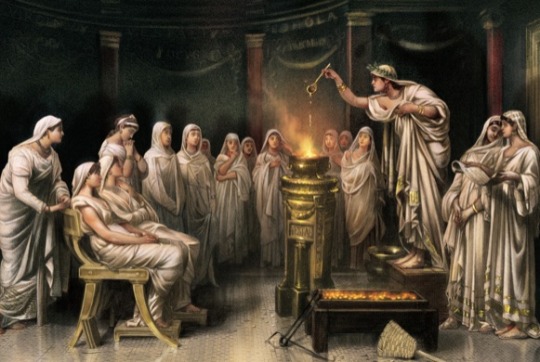
"The School of the Vestal Virgins" 19th-century colorized engraving by L. Hector Leroux.
After lots were drawn from the list of young girls who could serve Vesta, initiates were brought to the Atrium Vestae, where their training would begin. The training was overseen by the chief priestess, the Vestalis Maxima, who came under the authority of the Pontifex Maximus. The first 10 years were spent training for their duties. They would spend the second decade actively administering rites, and the final 10 were spent training novices. The chastity of the priestesses was a reflection of the health of Rome itself. Although spilling a virgin’s blood to kill her was a sin, this did not preclude the infliction of harsh corporal punishment. First-century historian Plutarch writes: “If these Vestals commit any minor fault, they are punishable by the high-priest only, who scourges the offender.”
Public monies and donations to the order funded the cult and the priestesses. In Rome religion and government were tightly intertwined. The organization of the state closely mirrored that of the basic Roman institution: the family. The center of life of the Roman home, or domus, was the hearth, tended by the matriarch for the good of her family and husband. In the same way, the Vestals tended Vesta’s flame for the good of the state.
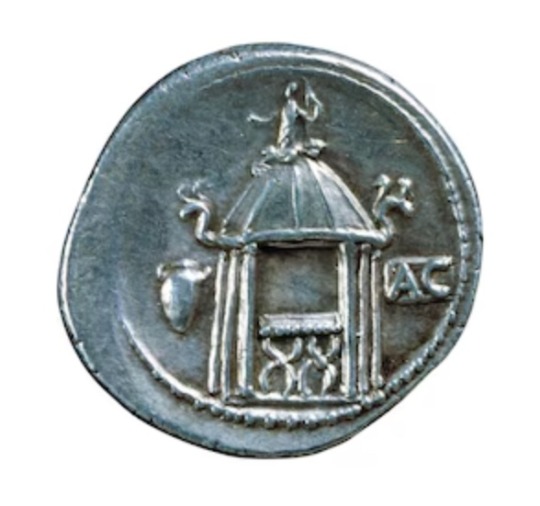
A silver denarius, also from the second century B.C., bears a representation of the circular Temple of Vesta.
Unlike other Roman women, Vestals enjoyed certain privileges: In addition to being able to own property and enjoying certain tax exemptions, Vestals were emancipated from their family’s patria potestas, patriarchal power. They could make their own wills and give evidence in a court of law without being obliged to swear an oath.
Thirty Years of Chastity
These rights came at a high price: 30 years of enforced chastity. Many historians believe that the health of the state was tied to the virtue of its women; because the Vestals’ purity was both highly visible and holy, penalties for a Vestal breaking her vow of chastity were draconian. As it was forbidden to shed a Vestal Virgin’s blood, the method of execution was immuration: being bricked up in a chamber and left to starve to death. Punishment for her sexual partner was just as brutal: death by whipping. Throughout Roman history, instances are cited of these grim sentences being passed.
Jealousy or malice made the women vulnerable to false accusations. One story, celebrated by several Roman writers, concerns the miracle of the Vestal Virgin Tuccia, who was falsely accused of being unchaste. According to tradition, Tuccia beseeched Vesta for help and miraculously proved her innocence by carrying a sieve full of water from the Tiber.
Allegations of crimes against the Vestals’ chastity sometimes went to the top of the social order. The flamboyantly eccentric, third-century emperor Elagabalus actually married a serving Vestal Virgin. It is a sign of the enduring symbolic importance of the cult that this heresy was one major factor that led to his deposal and murder.

The Vestal Tuccia, falsey accused of breaking her chastity vow, is saved by the intervention of Vesta, who enables her to carry water in a sieve from the Tiber back to the temple. 17th-century painting by Giovanni Battista Beinaschi.
Vestal Vestments
The ceremonial dress of Vestals highlights their dual, and somewhat contradictory, embodiment of both the maternal and the chaste. Physical appearance was an integral part of their role, making them stand out as different from other women, but also echoing physical traits of conventional women.
Dressed in white, the color of purity, the Vestal Virgins wore stola, long gowns worn by Roman matrons. Hair and headdresses played an important symbolic function. The Vestal hairstyle is described in Roman sources using an ancient Latin phrase, the seni crines. Historians cautiously agree it means “sixbraids,” and is mentioned as the coiffure of both Vestal Virgins and brides. A Vestal wore the suffibulum, a short, white cloth similar to a bride’s veil, kept in place with a brooch, the fibula. Around their heads they wore a headband, the infula, which was associated with Roman matrons.
Daily rites for Vestals were often centered around the temple. Most important was maintaining the holy fire. If the fire went out, the attending Vestals would be suspected not only of neglect but also of licentiousness, since it was believed impurity in a Vestal’s relations would cause a fire to go out. Other typical duties included the purification of the temple with water, which had to be drawn from a running stream. In readiness for the numerous festivals that required their attendance, the priestesses were required to bake salsa mola, a cake of meal and salt that was sprinkled on the horns of sacrificed animals. Important religious festivals included the Vestalia, dedicated to their goddess, Vesta, and the Lupercalia, which highlights the contradictory role of the Vestal Virgins, as it was closely associated with fertility.

A representation of a Vestal Virgin.
A Roman Tradition

A bust of Numa Pompilius from the Villa Albani Museum in Rome, believed to have been sculpted in the Roman Imperial Period.
Romans believed the cult of the Vestal Virgins was instituted under the eighth-century B.C. king Numa Pompilius, the successor of Rome’s founder, Romulus. First-century A.D. historian Plutarch wrote that Numa may have “considered the nature of fire to be pure and uncorrupted and so entrusted it to uncontaminated and undefiled bodies.“ Numa is credited by Livy, in his History of Rome, with formalizing other key Roman cults, including those of Jupiter and Mars. Many historians believe Numa was legendary, and that the worship of Vesta and other cults developed slowly out of pre-Roman customs, perhaps dating back to the older Etruscan culture that dominated Italy before the rise of Rome.
In the innermost part of their temple, the priestesses looked after their secret talismans. Among these objects was the sacred phallus, the fascinus, the representation of a minor god of the same name. The fascinus (the root of the word “fascinate”) is closely bound with magic and fertility. It was also in this part of the temple that they probably kept the palladium, the statue of Pallas Athena that the legendary founder of Rome, Aeneas, brought to Italy after the destruction of Troy, his home city—another aspect of the Vestal cult that tied Rome’s origins into an ennobling and ancient tradition.
Romans regarded these priestesses with a sense of awe. Plutarch points out “they were also keepers of other divine secrets, concealed from all but themselves.” It was believed they possessed magical powers: If anybody condemned to death saw a Vestal on his way to being executed, he was to be freed, so long as it could be proven the meeting was not by design. Vestals, it was said, could stop a runaway slave in his tracks.
The privileged position of the Vestal Virgins in Roman society survived for more than a thousand years, passing through Rome’s changing systems of monarchy, republic, and empire. The cult would not, however, survive Christianity. In A.D. 394 Theodosius closed the House of the Vestals forever, freeing the virgins from their obligations, but also removing their privileges.

VIEW OF THE VESTAThe ruins of the Atrium Vestae stand in the Roman Forum. The rectangular pools formed a part of the complex’s long, central patio. To the right of the Atrium are the remains of the Temple of Vesta, and behind the wall are the three remaining columns of the Temple of Castor and Pollux.
Even as their flame was extinguished, aspects of the cult may have passed into the new faith as it swept through the Mediterranean. Just as the position of the Pontifex Maximus lived on in the papal title “pontiff,” young women in the early years of Roman Christianity embraced virginity and celibacy in their desire to be “eunuchs for the love of heaven.” Scholars believe the role of the Christian nun was inspired, in part, by the chaste figures who dutifully tended the holy flame of Vesta.
By Elda Biggi.




#Vestals#Vestal Virgins#Priestesses of Vesta#Rome's Vestal Virgins: Protectors of The City's Sacred Flame#ancient artifacts#archeology#archeolgst#history#history news#ancient history#ancient culture#ancient civilizations#ancient rome#roman history#roman empire#roman emperors#roman art#ancient art#art history#long post#long reads
33 notes
·
View notes
Text
The art of Perrault (2)
Continuing from this post, there is another segment of the article which is absolutely delightful: the one about the "Fairy tale salon" of Jean Veber

Because Perrault didn't just inspire paintings and drawings - furniture too!
In the beginning of the 20th century, Jean Veber (a student of both Alexandre Cabanel and Robert Delaunay) was doing a lot of fairy-themed expositions, and when he was asked by Rosemonde Gérard (the wife of Edmond Rostand) to create her "boudoir" at their Arnaga villa (Cambo, Pays Basque), he chose "fairy tales" as his theme. He notably composed there beautiful wall paintings that attracted the attention of both Léon Bérard (under-secretary of state of the Beaux-Arts) and Gustave Geffroy, the administrator of the Gobelins Manufacture.
(Here is a Sleeping Beauty mural):

In 1912, Gustave Geffroy paid Veber to create an entire salon themed after Charles Perrault's fairy tales - tapestries and various sitting-furnitures. The plans for the salon were originally ambitious, but it was restricted due to limited money - else we would have had five tapestries and thirteen furnitures, including a bed, and many more "chairs" of various models (chaise, fauteuil, bergères). Instead, the "Contes de fées" salon gathers three tapestries, four armchairs, four regular chairs, a sofa, and a fireplace screen - now all preserved in the Mobilier national collection. (The two additional tapestries would have been Puss in Boots and Donkey Skin)
(Here's the Puss in Boots armchair)

(And the Bluebeard sofa)

After the newspapers mediatized madame Rostand's boudoir in the beginning of the 1910s, the Gobelins immediately asked Veber painted preparations of the Sleeping Beauty and Little Thumbling tapestries. In the 1914 he was commissioned the drawings for the various chairs by the Beauvais manufactury - specialized in chair tapestry. The project was interrupted by the First World war, but it began agan in 1919, year where the drawing for the Bluebeard sofa was made. The project got faster by the 1920s, thanks to the collaboration of the cabinet-maker Paul Follot. The entirety of the furniture was delivered by the end of 1922, after the Little Thumbling and Sleeping Beauties tapestries had been completed (1919-1920). The Cinderella tapestry (prepared by 1919) and the Beauty and the Beast screen won't be woven until 1923 and 1926.
(Sleeping Beauty silk-and-wool weavework)


The aesthetic of Veber's paintings evoke the paintings that cover the walls of the Arnaga villa: frize disposition and very colorful.
(Preparation work for the Cinderella tapestry)

These creations appeared half-a-century after Gustave Doré's illustrations, and in many ways oppose them. Here we have a sentimental, idealized, almost childish view of Perrault's story. Everything is light-hearted and funny, and the terror of the tales is removed - even the most frightening characters are merely grotesque. This is due to how, in this era, fairytales had been massively shared and spread as children literature, as well as to the nature of Veber's commission: indeed, the creation of a salon requires a peaceful and comforting ambiance, where someone can rest. He can't possibly put Doré images in there. After the First World War, this literary theme allows one to find back a sort of lightness - the tapestries of Beauvais being in harmony with the walnut-wood furniture, all golden and in curvy shapes.
(Beauty and the Beast fireplace screen)

Far from doing a "composition monotony", Veber makes sure each of the tapestries has been conceived in a different way, to offer a large palette of movement and dynamics. For Sleeping Beauty and Cinderella he chose specific moments of the tale. In the first, we have the prince charming rushing to the side of his beloved, in the middle of a thick vegetation filled with asleep characters. In the second, we see Cinderella fleeing the ball, her rushing carriage preventing the prince from stopping her. However, for Little Thumbling several key moments of the tale are presented side-by-side, so that in one glance the whole story is offered in a condensed version.
(Little Thumbling silk-and-wool weavework)

The "Contes de fées" salon of Veber is another example of the universality of Perrault, which can extend further beyond the world of the page, and into the decoration of walls and furnitures. The originality of this project seduced people at the time, and the Beauvais manufecture immediately demanded a new work from the artist: an "Animals in the forest" project for which he created four chairs, three armchairs and a screen. Delivered in 1925, this set can be considered a continuation of his "Fairy tales" salon.
(Armchair of the Foxes)

#jean veber#french things#perrault fairytales#french fairytales#fairytale illustrations#fairytale art#fairytale furniture#cinderella#sleeping beauty#little thumbling#furniture#tapestry#fairy tales salon
20 notes
·
View notes
Text
"Thai BL The Finest" Screening: I Feel You Linger In The Air & Scent of Memory
Hosted By Panoramist Spotlight

Date: 9:30-14:00 (Berlin), Saturday, 02/24/2024
Location: Colosseum (Schönhauser Allee 123, Berlin, 10437)
Public tickets (15€) available at https://shorturl.at/mDKMS
Details
Highly-acclaimed and award-winning in Thailand and abroad, "I Feel You Linger in the Air" is a Thai historical BL series with a fantasy twist, adapted from a popular Thai novel of the same title that has been translated into several foreign languages including English, German and Italian. It was co-produced by YYDS Entertainment and Dee Hup House and released in 2023.
The boys-love, or BL, series are those that depict a romantic relationship between two male protagonists. Originated from Japan, it is also acknowledged as a fascinating aspect of Thailand’s popular culture, showing the country's increasing openness towards people with different ways of life. In the past years, it has been continuously gaining popularity around the world.
"I Feel You Linger in the Air" tells a story about Jom, an architect in Chiang Mai overseeing the renovation of a rundown villa, continuously dreaming of a man he's never met. After his boyfriend broke up him for a woman, Jom is devastated, driving into a river. After regaining consciousness, he finds himself stuck in the time of 1927. In this unfamiliar world, he finally encounters the mysterious man from his dreams - Mr. Yai, and starts a bitter sweet love affair that defies social status, gender expectation, time and space.
"From the fantasy premise to the historical setting, I Feel You Linger in the Air is one of the most extraordinary BL dramas. Each fascinating storyline explores the past era and examines cultural nuances insightfully. It tackles many complex themes, including class differences, womanhood, and LGBTQ+ experiences. Thanks to the couple's enchanting chemistry, I'm spellbound by their majestic romance. Everything about this series evokes epicness." — blwatcher.com review
Therefore, we delightedly invite YYDS Entertainment to bring this masterpiece to Berlin for a public screening during the Berlinale, along with its special episode "Scent of Memory" that has not yet officially released globally. Beside screening, we will also have YYDS CEO Ms. Wan Thabkrajang to share some behind-the-scene stories and introduce the company and Thai BL production industry. She will also present a spoiler video of YYDS' upcoming BL series "My Stand-in".
We also prepare a souvenir gift that we hope can help keep this series lingering longer in your memory. The number is limited and will be given out on the first come first serve basis.
Planned agenda
9:30-12:00 I Feel You Linger in the Air (movie version)
12:15-13:45 Scent of Memory
13:45-14:10 Dialogue with YYDS Entertainment
I Feel You Linger in the Air Official Teaser Scent of Memory Official Trailer
Invite your friends to enjoy one of the finest Thai BL series together. Let this love linger in the air of Berlin ~
#i feel you linger in the air#ifylita#my stand in the series#my stand in#yyds entertainment#yaijom#bright rapheephong#nonkul chanon#i feel you linger in the air special episode#berlinale#i feel you linger in the air special ep#no because i find it a CRIME that european fans get to pay 1/4 of the price that thai fans paid for the special ep screening
31 notes
·
View notes
Text
So much is going on in this relatively short chapter. We learn a thing or two about Montfermeil during Hugo’s era (a town with plaster villas and bourgeois) and back in 1823, when it had problems with drinking water. Almost immediately after this revelation, Cosette, referred to as 'the poor creature,' is reintroduced, highlighting her greatest fear of venturing out after dark to fetch water.
The narrative then shifts, presenting a kaleidoscope of scenes and themes (it comes out that kaleidoscopes were in fashion in 1823). We're immersed in a Christmas fair and a wandering menagerie featuring Brazilian vultures sporting 'a tricolored cockade for an eye'—an attraction likely to evoke nostalgia among local Bonapartists for bygone days. (I had to look for that bird: it’s not just its eye—good, initially I worried that it was somehow mutilated—but the entire head is adorned in red, blue, and whitish-yellowish hues. To be honest, tricolour is the last thing I would think of looking at this creature). Fragments of peasants' conversations at the tavern offer a glimpse into Hugo's early attempts at creating a polyphonic effect, a technique that will unfold further in subsequent Revolution chapters.
The chapter concludes with the poignant introduction of two children, criminally neglected by the Thénardiers. Cosette, with her bare feet exposed to the winter cold, diligently knitting stockings for other children, juxtaposed with Gavroche, who bursts forth with a cry. The scene is complete with a chilling detail—a whip ominously hanging on the wall. Poor children.

21 notes
·
View notes
Text

Vemdalen Villas is a minimalist home located in Härjedalen, Sweden, designed by Hesselbrand. This development is notable for its strategic placement that allows for direct access to skiing slopes and panoramic views of the encompassing valley. Each housing unit comprises a primary residence alongside a guest house, arranged in a manner that cultivates small communal outdoor areas and walking paths, thereby evoking the ambiance of a village rather than a conventional residential street.
17 notes
·
View notes
Text

Leander meets Ji Ho and Jeb at Villa Elba.
And Wesley awaits Saiwa, Vlad and Jack at Hummelshain Castle.

The truth about Luci
Leander: "Before I begin, I want you to know that none of us had planned this. We just decided to not tell you until we defeated the Council. There was too much at stake for us to put it at risk. For this I apologize."

Leander: "I already told you that, after Vlad died, I was able to save the largest part of his soul from vanishing into Nirwana by dragging him into the realm where Wes and I had escaped to after we died. Though, there were still a few remnants of him left in his body. Parts of his heart, memories... your bond - and his love for you."
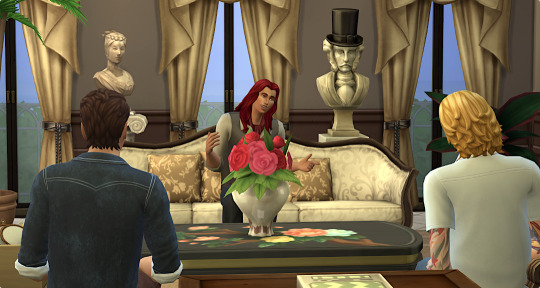
Wesley to Vlad: "And when I felt through our old bond that someone (Morgan) was about to revive your body, Leander sacrificed parts of our life force to leave our realm and stop her. But it was too late and your body came to life without your soul."

Wesley: "From what we know is, that when one of a bonded couple dies, the other one is condemned to die too. But Ji Ho didn't. A bond lives off of the love of it's owners and grows stronger through this love. Your bond, still present in your body, evolved a life of it's own. It started to act for it's own needs to survive. And the primary need of a bond is to keep it's owners - you and Ji Ho - loving each other to 'feed' it so it can survive and grow." Vlad: "What are you trying to tell me?"

Wesley: "You are Luci. The remnants of you and the bond." Vlad: "Are you crazy? Is Leander telling this nonsense Ji Ho right now? I'm going to kill him!"

Wesley: "Calm down! For Ji Ho! Didn't you notice that he's fading away since Luci left him? Luci/the bond pushed you through winter and summer solstice to close the circle and evoke your powers before he left. He did it for this reason only - and to erase the fears Ji Ho had that kept him from being with you! Ji Ho deserves to know. It's up to you now. Give him time to process it. He must have loved you too. Otherwise the bond would never have grown that strong. You and I were never able to evoke such strong powers - neither could Ji Ho and Genji. Look what became of Leander and me. He wanted to marry you and I killed him - and even we are lovers now." Vlad: "I will never be able to face him again after he learned about this."
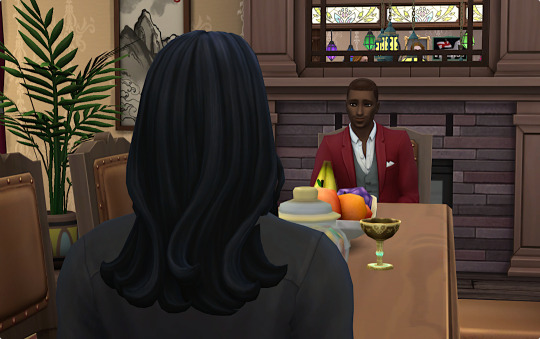
Jeb to Leander: "How could you let this happen! And I mean all of you! And what for?" Leander: "It was for the greater good. You need to realize that the deeds of the Council affect all of us. And all of us have to make sacrifices."
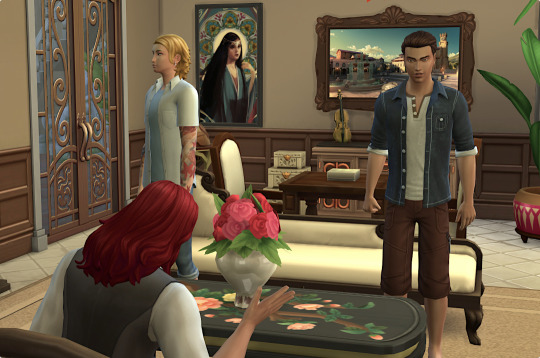
Ji Ho: "I will never be able to face him again after he learned about this. I caused him so much pain because I fell in love with - a thing that doesn't exist…"

'Da quando sei partito è cominciata per me la solitudine Ricominciare insieme, ti voglio tanto bene. ll tempo vola, aspettami. Tornerò, pensami sempre, sai, e il tempo passerà.
Since you left me alone, I'm surrounded by loneliness. Let's start all over again, I love you so much Time flies, wait for me - I'll come back Think of me always you know the time will pass.'
Tornero - I santo California I added the song to the 'Summer at Tartosa' playlist on youtube and spotify.
From the Beginning ~ Underwater Love ~ Latest
#Summer at Tartosa#sims 4 story#simblr#ts4#sims 4#woo ji ho#vladimir tepesz#jack callahan#giga byte#saiwa#jeb harris#underwater love#tartosa#villa elba#schloss hummelshain#Leander Belgraves#Wesley Kareem
51 notes
·
View notes
Text

In Memoriam: the truly great and berserk operatic Polska singer, actress and all-purpose diva Violetta Villas (née Czesława Maria Cieślak, 10 June 1938 - 5 December 2011) died on this day aged 73. For anyone not au fait with the wild, wild world of the tempestuous Villas, think of her as an ultra-campy, kitsch outsider artist; a wild low-budget Eastern European hybrid of Yma Sumac, Jayne Mansfield, Anita Ekberg in La Dolce Vita, Brigitte Bardot and Charo; a punk (her image and un-hinged performances can suggest Nina Hagen or Jayne County); and the self-parodic possessor of a drag queen sensibility (is it deliberate or naive? Certainly, her persona evokes the films of the Kuchar brothers and John Waters). Dubbed "the voice of the atomic age”, Villas was a celebrated Las Vegas headliner in the 1960s and even appeared in some Hollywood films, but her promising international career was cut short by Communism (she bounced back in the 1980s and never stopped being venerated in Europe). I revere this woman and wish she was more embraced as a queer icon in the non-Polish speaking world. I highly recommend investigating old clips of Villas on YouTube – prepare to have your mind blown!
#violetta villas#polska diva#polska yma sumac#kween#hair hopper#kitsch#diva#outsider artist#lobotomy room#camp#punk#false eyelashes#bouffant hair#lgbtqia#polish diva#gay icon#kitsch icon#camp icon#lgbtqia icon
9 notes
·
View notes
Text
A moment stuck in time
(Post Happyland Drabble) (bgm)
They were about to return home, the island previously full of life now seeming so empty. Seeing inside the Villa, a little pocket in time, made his heart hurt. So much love must’ve gone into these rooms, all those toys…. There were more than he could’ve ever dreamed of. He wondered if they were all loved and played with at one point.. Like he loved his own stuffed rabbit.
But it was over now, wasn’t it?
These poor toys, he wondered if they’ll be forgotten. A fading memory only to those who set foot on the island. Fading together with their master.. that’s just too sad. He didn’t know who the master of the villa might’ve been. An old toymaker? A small child? What was the history of this place? It evoked a sentimentality he didn’t know he had.
He was about to step back outside, when his foot hit something. One plushie, a seeming outlier away from the other piles. It was dusty, but recognizable as an animal of some sorts. Gently, with soft hands he picked it up and brushed off the layer of dust, revealing a cute looking white creature.
A soft smile.
He looked around. Was anyone watching?
A warm hug. He wondered when the last time was this toy received one?
“Don’t worry. I’ll be your friend now.”
#(drabble: magic to make you happy!)#//sorry I went insane for a moment I had to write this FNDNDJDB#//ty for the event mods I’m sobbing crying screaming#//if this messes with anything btw just let me know I’ll delete it or mark it as non canon
4 notes
·
View notes
Text
'What would “Ripley” be without its transfixing style, from the palpable isolation of a squalid New York apartment to the shadowy charms of ancient Italian streets?
Writer-director Steven Zaillian’s acclaimed eight-hour Netflix series isn’t merely a new adaptation of Patricia Highsmith’s enduring thriller about an American tourist in coastal southern Italy embracing deceit and murder: It’s a coolly gorgeous black-and-white pleasure bath of sights, shades and textures. Beauty with darkness. Modern touches in ancient spaces. Art for con artist’s sake.
To achieve his vision of a 1960s Italy that would sweep viewers away right along with Andrew Scott’s dangerously impressionable protagonist, Zaillian assembled a murderer’s row (ahem) of design collaborators: Oscar-winning cinematographer Robert Elswit, who’d worked with the director on the miniseries “The Night Of���; production designer David Gropman, an alum of Zaillian’s 1993 film “Searching for Bobby Fischer”; and Italian costume designers Maurizio Millenotti and Gianni Casalnuovo.
Elswit makes no bones about how important everyone’s set contributions were to the look and feel of “Ripley.” “It was such a clear ensemble of decisions based on Steve’s original ideas that we pursued for the whole [show],” he says. “We wanted to underlie the drama, be part of the storytelling, part of the emotional life of it.”
The production design
“A dream job” is how Gropman describes working on “Ripley,” starting with what Zaillian’s 400 dialogue-sparse script pages evoked, and ending with myriad locations across New York, Italy and at Rome’s fabled Cinecitta studios.
Early research led Gropman to the kinds of images that called out to be re-created. “When you’re doing Tom on the train from Cherbourg to Naples, and you pull up David Seymour’s photograph of Ingrid Bergman going from Naples to Cannes on the Orient Express, you know exactly what that train car looks like in black and white.” Another inspiring source was Piergiorgio Branzi, revered for his naturalistic postwar pictures of life in Italy. “Any photograph of his would fill a moment in [‘Ripley’].”
Months of scouting the Amalfi coast for the sleepy town holding Dickie Greenleaf’s villa led Gropman to quiet but picturesque Atrani. Three elements cinched it: The views from the road above were stunning, the piazza charmed, and what would become something of a location star for rapt viewers, “the incredible network of stairs, alleys and passageways.” The actual villa, however, was discovered in Capri, and completely outfitted in midcentury furniture and assorted antiques and artwork.
You can get to 200 locations and sets easily when a character is constantly on the move, and the norm is to crib from many places to suggest one. “For the Excelsior hotel in Rome,” says Gropman, “the exterior was the Hassler, the lobby was the Plaza, and two suites were an amazing 16th century palazzo in the middle of Rome.” And where exterior period authenticity couldn’t be counted on, CGI filled out plenty of backgrounds. “Train platforms, views out windows, and ferry docks were all big visual effects set extensions,” Gropman says.
As for what was built at Cinecitta, two favorite sets for Gropman were Tom’s New York hovel and his well-appointed, furnished Rome apartment. For every set, though, walls were never moved for the camera’s sake, “so you’re true to the claustrophobia,” says Gropman, and in the case of the dingy New York SRO, “the meanness of that space.”
Props were nearly as important, and Zaillian spent two days looking at demos. One story item, however — a Murano glass ashtray whose importance won’t be spoiled here — had already been chosen. “The ashtray is on one of Steve’s side tables at home in California,” says Gropman, laughing. “That will tell you a lot about Steve, and his ‘Ripley.’”
The cinematography
“Steve is the most meticulous, focused, precise director you could ever work with,” says Elswit of his “Ripley” writer-director. “He had a very clear concept of shooting in black and white, making a designed movie formally organized around tonal structure and graphic images.”
Elswit, who’s previously worked in black and white (“Good Night and Good Luck”), explains why cinematographers love the monochrome palette. “You can exploit the extremes between the brightest white and the blackest black. You exaggerate the contrast in their faces. You can feel it. Sense it. You really do create tension and anxiety through lighting. It’s been done since the beginning of movies.”
It’s even baked into Zaillian’s script. Ripley’s fascination with Caravaggio allowed the Italian master’s famed tenebrism — intense darkness and pockets of equally intense light — to also become a guiding aesthetic for Elswit. Caravaggio “was also obsessed with quality of light, its direction and the reality of it. Like a spotlight on what was interesting.”
Elswit says Italy’s very physicality lends itself to such extremes of light and shadow. “There’s so much texture when you’re looking at walls, streets, the surfaces of buildings, the cobblestones, stairways. It’s granite, plaster, rock, marble, whatever it is, and in black and white, it emphasizes the texture.”
Caravaggio and his era’s peers influenced the show’s look in another way. Elswit and Zaillian gave themselves an unusual rule in framing, to keep Renaissance and Baroque art’s straight-ahead perspective and avoid converging vertical lines, as would happen if a camera tilted up or down. It’s why so much of “Ripley” is a crisply edited procession of static shots, with only humans providing movement.
“That was built into every setup, indoors and out,” Elswit says. “We were going to have the picture plane parallel to the walls of structures we were shooting, always. The buildings couldn’t have converging lines. Steven wanted that formal graphic design.”
Zaillian also preferred overcast days, to avoid any sun-kissed hint of romance and warmth. But Elswit made great portentous use of a hot sky for when Ripley first encounters Dickie and Marge, lying on the gravel beach. “We had a high shot where we had Tom walk by them, and his shadow goes over them,” Elswit says. “I was thrilled. I’m not sure if Steve was at the time, but he ended up being happy with it. That was a wonderful advantage to a sunlit day!”
The costumes
Italy in the ‘60s may have been a fashion mecca, but that wasn’t how Millenotti and Casalnuovo saw the job Zaillian set out for them. “There was a focus on subtlety,” Casalnuovo wrote via email, speaking for the duo. “The costumes shouldn’t be flashy or distracting. Steve’s vision emphasized creating a sense of character and story through the clothing.”
Casting a wide net in their research — with a little over four months of pre-production time — the pair pored over photo books, archives, even vintage albums found in street markets, “searching for a nuanced understanding of the period,” Casalnuovo says. Their rummaging unearthed one socked-away trove containing unpublished pictures of everyday life in the story’s key cities. “This provided invaluable insight into the social fabric and atmosphere. This allowed us to create costumes steeped in authenticity and narrative depth.”
That meant capturing a moment when the world was turning away from formality, while areas like southern Italy still reflected class divisions. Lighter fabrics such as linen and cotton are presenting themselves, and yet the privilege Dickie Greenleaf (Johnny Flynn) represents hasn’t gone away. “Dickie’s wardrobe would be more tailored and polished. In contrast, characters of lower social standing would wear simpler, more practical clothing.”
With a black-and-white palette, however, certain scenes needed extra consideration, as when Tom Ripley’s swimsuit needed to set him apart at the beach. Highsmith wrote about a garish yellow/black checkered pair of trunks, but, says Casalnuovo, “a color contrast wouldn’t translate.” (As the final decision ultimately showed, an eye-opening fit and pattern humorously did the trick.)
Of course, when it came to Ripley overall, charting his sartorial trajectory, not surprisingly, was the designers’ most enjoyable project. “Ripley’s wardrobe is a chameleon’s act. Initially, his casual American style clashes with Dickie’s European flair. He subtly incorporates elements like polo shirts and loafers, mirroring Dickie to gain acceptance.” Getting from high-priced mimicry to Tom’s own personal style toward the end was a particular challenge, but the kind costume designers live for. “It was a process that demanded focus and a deep understanding of the character, but seeing it all come together was incredibly rewarding.”'
#Netflix#Ripley#David Gropman#Maurizio Millenotti#Patricia Highsmith#The Talented Mr Ripley#Robert Elswit#Gianni Casalnuovo#Andrew Scott#Amalfi Coast#Atrani#Capri#Caravaggio#Rome#Dickie Greenleaf#Johnny Flynn
3 notes
·
View notes
Text
Barbie (2023)

Allan’s gaze is a symphony of sadness. How has Michael Cera not aged a day since Scott Pilgrim vs the World? Ageless to is his puppy-dog ennui which he channels so effortlessly. The fact that he’s tertiary at most but still worthy of mention speaks to just how stacked the casting of Barbie was. All of our Barbies and Kens are ostensibly the same, and yet they are all infectiously fun to watch. President Barbie is just happy to be there, Simu Ken is so much more effortlessly dorky-cool than the others, and Midge, well… we don’t talk about her much. Who better than Kate McKinnon to embody those dolls that get roughed up more than others? Will Ferrell is… well, he’s doing his cutesy-weird thing which worked as the father figure in the LEGO Movie but is just off-putting here. Helming it all is the unstoppable duo of Margot Robbie and Ryan Gosling. Robbie’s journey from a life of total but unfulfilling happiness to the leap into the unknown is about as committed and authentic as the movie will allow, and Gosling is the ideal vapid limbo who 100% isn’t gay. For real, he’s just fabulous.
But Barbie is nothing without her accessories, right? The other major standout of Greta Gerwig’s creation is its immaculately fantastical production design. Much like The LEGO Movie, this takes a pointedly and intentionally artificial approach. Nothing looks real because nothing should; this is a pretend land where everything is perfect and controlled. Products are integrated into the background to create enough Easter eggs to make the most die-hard Bar die fanatic happy. But it moves farther than that. This is a constructed fake world, in a literal sense. These are real Dreamhouses and props that the characters interact with, creating a tactility not unlike the experience of playing with a doll and imagining her immaculate world. Painted mountain backdrops and static waves keep this at a remove from direct reality, keeping this realized but not real. In a way, this feels like a postmodern Powell and Pressburger film, evoking Old Hollywood soundstages and painterly sets while telling a story with new sensibilities. Weird Barbies house with its winding path has to be a direct reference to The Red Shoes and its villa where the men revamp their ballet. There is Busby Berkeley too, eluded to in Barbie’s bespoke party but elevated to apotheosis in the Kenergy of the ir storming of the beach.
THE RULES
SIP
Someone says "Hi, Barbie!"
A pop song begins.
Ken is really into horses.
BIG DRINK
Someone travels to or from Barbie Land.
The movie makes a reference to a classic film.
Barbie cries.
#drinking games#barbie#barbenheimer#greta gerwig#margot robbie#ryan gosling#america ferrera#comedy#michael cera#kate mckinnon#simu liu#helen mirren#kingsley ben-adir#w*ll forte#dula peep
3 notes
·
View notes
Text
The Tranquility of Sunset on Maldives' Beautiful Beaches
As the golden sun begins its descent over the turquoise waters of the maldives, a serene and enchanting atmosphere blankets the picturesque beaches, setting the stage for a breathtaking display of nature's beauty. The tranquil embrace of the sunset in this paradisiacal archipelago invokes a sense of peace and wonder that captivates all who bear witness to its ethereal allure. The vibrant hues of red, orange, and pink paint the sky, merging seamlessly with the gentle lapping of waves against the pristine shores. As the sun gracefully sinks below the horizon, a tranquil ambiance takes over, casting a magical spell over the landscape. The shifting colors and the softening glow create a perfect harmony with the gentle rustle of palm leaves and the distant whispers of the sea, inviting visitors to pause and immerse themselves in the serene spectacle, evoking a sense of inner peace and awe. In this oasis of tranquility, the sunset on the maldives' beautiful beaches promises a moment of blissful escape and an appreciation for the beauty that nature bestows upon us.
The Mesmerizing Palette of Colors
As the sunset maldives beach begins its descent on the horizon of the Maldives' pristine beaches, a breathtaking transformation of the sky unfolds. The first paragraph of our journey into the tranquility of a Maldivian sunset immerses us in the awe-inspiring display of colors. Brilliant shades of orange, pink, and purple paint the heavens, blending seamlessly with the azure waters of the Indian Ocean. This surreal spectacle is a visual symphony that captivates all who are fortunate enough to witness it, a harmonious fusion of nature's finest hues.
Nature's Serene Soundtrack
As we delve deeper into the Maldivian sunset experience, the second paragraph unveils another layer of tranquility - the soothing soundtrack of nature. The gentle lapping of waves against the powdery white sands forms a rhythmic melody, while the distant calls of seagulls provide a harmonious counterpoint. This symphony of sounds, carried by the warm tropical breeze, creates an auditory haven, transporting you to a realm of pure relaxation and serenity.
A Moment of Reflection
Stepping into the third paragraph, we explore the introspective aspects of a Maldivian sunset. As the sun sinks lower, its reflective dance on the tranquil waters invites contemplation. The shifting patterns of light and shadow encourage a moment of introspection, allowing you to connect with your inner thoughts and feelings. Whether you're strolling along the shoreline or simply gazing from your beachfront villa, this tranquil moment provides a unique opportunity for self-discovery and mindfulness.
The Scent of the Sea
Our journey into the sunset's tranquility continues with a sensory exploration. The fourth paragraph introduces the subtle yet invigorating scent of the sea. The briny aroma, carried by the ocean breeze, refreshes the senses and evokes a deep sense of calm. It's a reminder of the ocean's vastness and the inherent beauty of the natural world, grounding you in the present moment and inviting you to savor every breath.
Time Slows Down
In the fifth paragraph, we delve into the sensation of time slowing down. As the sun hovers on the cusp of the horizon, it seems as though the world itself takes a pause. The rush of daily life recedes into the background, and you find yourself fully immersed in the present. This sensation of timelessness is a precious gift offered by the Maldivian sunset, inviting you to savor every fleeting moment.
Connection with Loved Ones
The sixth paragraph explores the power of a Maldivian sunset to strengthen connections with loved ones. Whether you're sharing this magical moment with family, friends, or a romantic partner, the experience fosters a sense of togetherness. Conversations become more meaningful, laughter more heartfelt, and bonds more profound as you bask in the warm glow of the setting sun.
A Lasting Impression
As our exploration of the Maldivian sunset draws to a close in the seventh paragraph, we reflect on the lasting impression it leaves on your soul. Long after the sun has dipped below the horizon, its tranquil beauty lingers in your memory. The sense of peace and serenity you've absorbed becomes a part of you, a treasured memory to carry with you, reminding you of the tranquil beauty of Maldives' beautiful beaches whenever you need a moment of escape.
Conclusion
In conclusion, experiencing the tranquility of sunset on the beautiful beaches of the Maldives is a truly magical and soul-enriching experience. As the golden sun gracefully dips below the horizon, painting the sky with vibrant hues of orange, pink, and purple, a profound sense of peace and serenity washes over you.
2 notes
·
View notes
Text
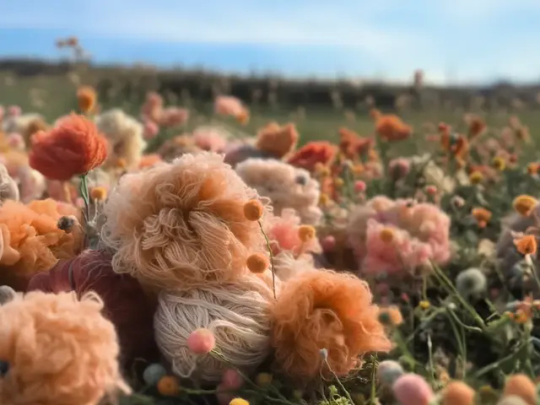
Pantone’s Color of the Year for 2024 'Peach Fuzz'
The gentle, pinkish-orange hue was chosen to reflect a collective desire for respite
A soft, pinkish-orange hue called “Peach Fuzz” is Pantone’s pick for the 2024 color of the year, the company announced last week.
Officially called “Pantone 13-1023 Peach Fuzz,” the color is “velvety,” “gentle” and “subtly sensual,” according to the design and color authority.
Pantone is best known for its color-matching system, created in the 1960s, that numbers and organizes hues with a distinct chip format. The company also runs the Pantone Color Institute, which selects the color of the year and conducts color trend forecasting research.
This year’s choice “echoes our innate yearning for closeness and connection,” says Leatrice Eiseman, executive director of the Pantone Color Institute, in a statement.
“We chose a color radiant with warmth and modern elegance,” she adds. “A shade that resonates with compassion, offers a tactile embrace and effortlessly bridges the youthful with the timeless.”
Peach Fuzz is Pantone’s 25th color of the year. The annual announcements began in 1999 to “engage the design community and color enthusiasts around the world in a conversation around color,” per a statement from Laurie Pressman, the Pantone Color Institute’s vice president.




Every year, a team of color experts examines movies, art, fashion, design, travel destinations, technologies and more to figure out which colors are influencing the world in the current moment. They also use forecasting tools, color psychology research and other sources to predict upcoming trends. From all that research, they narrow down the options to just one color that they feel sets the tone for the year ahead.
Peach Fuzz is less bold than last year’s choice, a bright, pink-red shade called “Viva Magenta.” But the world felt different in 2023, when Pantone “celebrated coming out of the malaise of the last year,” as Eiseman tells CNN’s Leah Dolan. Viva Magenta was intended to evoke verve, power and grace as the world emerged from the pandemic and continued to grapple with social unrest, as NPR’s Rachel Treisman wrote last year.


Heading into 2024, however, Peach Fuzz “arrives at a dark time amid a tumultuous war and a tense election year,” as Angelica Villa writes for ARTnews. The more muted hue is meant to reflect the “need for some quiet, some peace, some respite,” Eiseman tells CNN.
Where will Peach Fuzz show up in 2024? Rugs, wallpaper, fabric, makeup, tea and more—which are all examples of products released in conjunction with Pantone’s announcement. The color is already showing up in fashion, with celebrities like Taylor Swift and the Rock wearing Peach Fuzz to various events, notes USA Today’s Emily DeLetter.
“It feels like another rediscovered neutral that’s meant to seep its way into every surface of our lives,” said Jeremy Allen, the art director for the New York Times Styles Desk, in a conversation with colleagues.
By Sarah Kuta.
#Peach Fuzz#Pantone 13-1023 Peach Fuzz#Pantone’s Color of the Year for 2024 'Peach Fuzz'#Pantone’s 25th color of the year#Pantone Color Institute#color#colorful#style#design#art#artist#art work#art world#art news#pink#pretty in pink
33 notes
·
View notes
Text
Riyadh Welcomes SK Design : A New Hub for Innovative Interior Solutions
SK Design aims to transform living spaces and commercial establishments into artful and functional showcases while prioritizing sustainability, reflecting their commitment to enhancing the quality of life through exceptional design.

SK Design, founded and directed by principal Interior Architect, Mrs. Sara Khairallah, brings a wealth of experience and a passion for design that transcends boundaries. With a team of talented and creative designers, SK Design is poised to become a go-to destination for those seeking to transform their living spaces, offices, or commercial establishments into stunning showcases of artistry and functionality.
At the heart of SK Design’s mission is the belief that exceptional design is more than aesthetics; it’s about creating spaces that tell stories, evoke emotions, and enhance the quality of life. This vision is reflected in their comprehensive range of services, which include:
Residential Design: SK Design specializes in crafting homes that reflect the unique personality and lifestyle of their clients. Whether it’s a cozy apartment or a luxurious villa, their team of designers will work closely with homeowners to bring their dreams to life.
Commercial Spaces: From modern offices that promote productivity to hospitality venues that offer unforgettable experiences, SK Design’s expertise extends to the commercial sector. Their designs are tailored to enhance functionality while making a lasting impression.
Renovation and Remodeling: For those looking to breathe new life into existing spaces, SK Design offers renovation and remodeling services. Their team can revamp and refresh any interior, ensuring it aligns with the latest design trends.
Custom Furniture: To complement their design services, SK Design also offers custom furniture design and manufacturing. This allows clients to have one-of-a-kind pieces that perfectly suit their space.
Sustainable Design: Recognizing the importance of sustainability, SK Design integrates eco-friendly practices into their designs. They source sustainable materials and incorporate energy-efficient solutions whenever possible, contributing to a greener future.
Mrs. Sara Khairallah, the driving force behind SK Design, expressed excitement about the studio’s launch, saying, “Riyadh is a city filled with diverse tastes and unique design opportunities. We are thrilled to be a part of this vibrant community and look forward to creating exceptional interiors that resonate with our clients’ aspirations.”
#interior design#interior design studio#interior designer#interior architecture studio#residential design
2 notes
·
View notes
Text



Imagine sitting on a classic Italian chair, handcrafted by Royalzig Luxury Furniture, with a white distressed finish that evokes the old style charm of Italy. You can feel the softness of the beautiful fabric and the comfort of the upholstery, as you relax and enjoy a sip of coffee or a glass of wine. The elegant classic Italian style of this chair will make you feel relax in your luxurious villa, surrounded by art and culture. This chair is not just a piece of furniture, but a masterpiece that will enhance the experience and look of your home. Whether you place it in your living room, bedroom, or study, this chair will create a warm and inviting atmosphere, with its curved back, padded seat, and carved legs. The classic Italian chair is the perfect choice for anyone who appreciates quality, beauty, and craftsmanship.
#Classic Italian Chair#Classic Chair#Italian Chair#Italian Arm Chair by Royalzig online India#Luxury Chair by Royalzig Luxury Furniture
2 notes
·
View notes